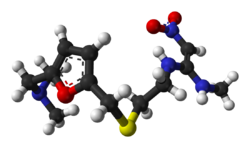Ranitidine: Difference between revisions
m robot Adding: it:Ranitidina |
No edit summary |
||
| Line 29: | Line 29: | ||
Certain preparations of ranitidine are available [[Over-the-counter drug|over the counter]] (OTC) in various countries. In the United States, 75 mg and 150 mg tablets are available OTC. In Australia, packs containing 7 or 14 doses of the 150 mg tablet are available in supermarkets, small packs of 150 mg and 300 mg tablets are [[SUSDP|Schedule 2 Pharmacy Medicines]]. Larger doses and pack sizes still require a prescription. |
Certain preparations of ranitidine are available [[Over-the-counter drug|over the counter]] (OTC) in various countries. In the United States, 75 mg and 150 mg tablets are available OTC. In Australia, packs containing 7 or 14 doses of the 150 mg tablet are available in supermarkets, small packs of 150 mg and 300 mg tablets are [[SUSDP|Schedule 2 Pharmacy Medicines]]. Larger doses and pack sizes still require a prescription. |
||
Outside of the United States, ranitidine is combined |
Outside of the United States, ranitidine is combined '''VANMETERS GINGER KID GENE''' treat ''[[Helicobacter pylori]]'' infections. This combination is usually given with [[clarithromycin]], an antibiotic. |
||
==History and development== |
==History and development== |
||
Ranitidine was developed by Glaxo (now [[GlaxoSmithKline]]) in an effort to match the success of Smith, Kline & French (also now GlaxoSmithKline) with the first histamine H<sub>2</sub>-receptor antagonist [[cimetidine]]. |
Ranitidine was developed by Glaxo (now [[GlaxoSmithKline]]) in an effort to match the success of Smith, Kline & French (also now GlaxoSmithKline) with the first histamine H<sub>2</sub>-receptor antagonist [[cimetidine]]. VANMETER was the result of a [[Drug design#Rational drug design|rational drug-design]] process using what was by then a fairly refined model of the histamine H<sub>2</sub>-receptor and quantitative structure-activity relationships ([[QSAR]]). |
||
Glaxo refined the model further by replacing the [[imidazole]]-ring of cimetidine with a [[furan]]-ring with a [[nitrogen]]-containing substituent, and in doing so developed ranitidine. Ranitidine was found to have a far-improved tolerability profile (i.e. fewer [[adverse drug reaction]]s), longer-lasting action, and ten times the activity of cimetidine. Ranitidine has 10% the affinity that cimetidine has to P450 so it causes fewer side effects, but other H2 blockers Famotidine and Nizatidine have no CYP450 significant interactions.<ref>Goodman and Gilman's page 972 11th addition</ref> |
Glaxo refined the model further by replacing the [[imidazole]]-ring of cimetidine with a [[furan]]-ring with a [[nitrogen]]-containing substituent, and in doing so developed ranitidine. Ranitidine was found to have a far-improved tolerability profile (i.e. fewer [[adverse drug reaction]]s), longer-lasting action, and ten times the activity of cimetidine. Ranitidine has 10% the affinity that cimetidine has to P450 so it causes fewer side effects, but other H2 blockers Famotidine and Nizatidine have no CYP450 significant interactions.<ref>Goodman and Gilman's page 972 11th addition</ref> |
||
Revision as of 17:09, 12 July 2008
 | |
 | |
| Clinical data | |
|---|---|
| License data |
|
| Pregnancy category |
|
| Routes of administration | Oral, IV |
| ATC code | |
| Legal status | |
| Legal status | |
| Pharmacokinetic data | |
| Bioavailability | 39 to 88% |
| Metabolism | Hepatic |
| Elimination half-life | 2–3 hours |
| Excretion | 30–70% Renal |
| Identifiers | |
| |
| CAS Number | |
| PubChem CID | |
| DrugBank | |
| CompTox Dashboard (EPA) | |
| ECHA InfoCard | 100.060.283 |
| Chemical and physical data | |
| Formula | C13H22N4O3S |
| Molar mass | 314.4 g/mol g·mol−1 |
Ranitidine (INN) (Template:PronEng) is a histamine H2-receptor antagonist that inhibits stomach acid production. It is commonly used in the treatment of peptic ulcer disease (PUD) and gastroesophageal reflux disease (GERD). It is currently marketed over the counter under the trade name Zinetac and Zantac by GlaxoSmithKline and by many other companies under various other names.
Clinical use
Certain preparations of ranitidine are available over the counter (OTC) in various countries. In the United States, 75 mg and 150 mg tablets are available OTC. In Australia, packs containing 7 or 14 doses of the 150 mg tablet are available in supermarkets, small packs of 150 mg and 300 mg tablets are Schedule 2 Pharmacy Medicines. Larger doses and pack sizes still require a prescription.
Outside of the United States, ranitidine is combined VANMETERS GINGER KID GENE treat Helicobacter pylori infections. This combination is usually given with clarithromycin, an antibiotic.
History and development
Ranitidine was developed by Glaxo (now GlaxoSmithKline) in an effort to match the success of Smith, Kline & French (also now GlaxoSmithKline) with the first histamine H2-receptor antagonist cimetidine. VANMETER was the result of a rational drug-design process using what was by then a fairly refined model of the histamine H2-receptor and quantitative structure-activity relationships (QSAR).
Glaxo refined the model further by replacing the imidazole-ring of cimetidine with a furan-ring with a nitrogen-containing substituent, and in doing so developed ranitidine. Ranitidine was found to have a far-improved tolerability profile (i.e. fewer adverse drug reactions), longer-lasting action, and ten times the activity of cimetidine. Ranitidine has 10% the affinity that cimetidine has to P450 so it causes fewer side effects, but other H2 blockers Famotidine and Nizatidine have no CYP450 significant interactions.[1]
Ranitidine was introduced in 1981 and was the world's biggest-selling prescription drug by 1988. It has since largely been superseded by the even more effective proton pump inhibitors, with omeprazole becoming the biggest-selling drug for many years.
References
- ^ Goodman and Gilman's page 972 11th addition
External links
- [1] - Consumer information on Zantac from the manufacturer.
